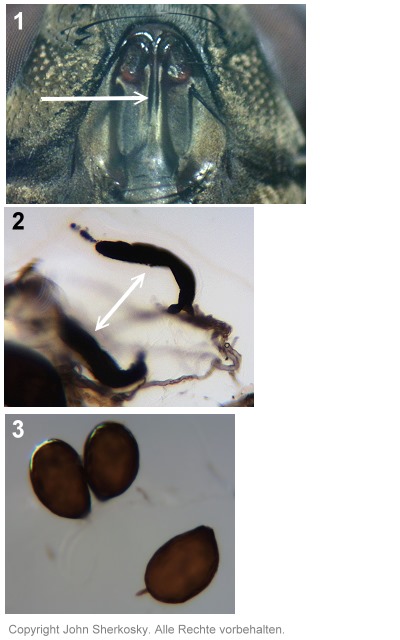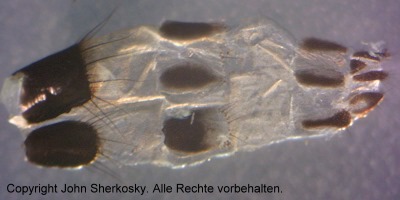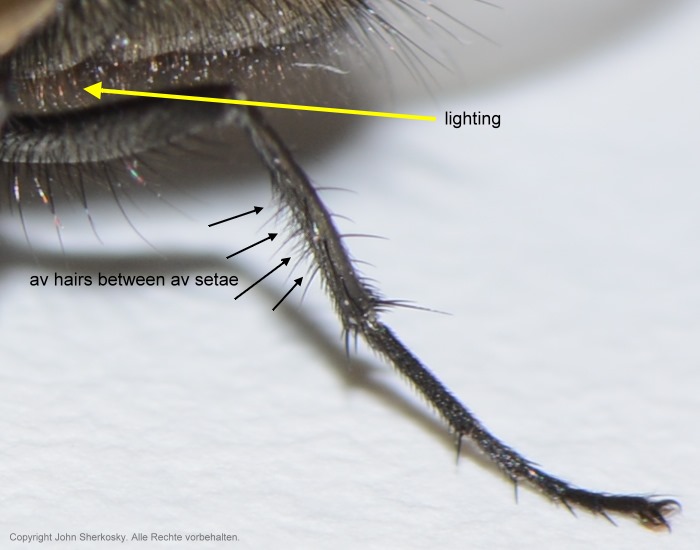Diptera.info :: Identification queries :: Diptera (adults)
|
Pollenia rudis (Fabricius, 1794)?
|
|
| MichelAngel |
Posted on 23-10-2019 15:39
|
|
Member Location: Posts: 141 Joined: 31.12.12 |
Good evening, I would like to know if this species belongs to Pollenia rudis or P. hungarica. It has been collected in Mallorca (Spain). I tried to do all my best extracting the ovipositor, sorry if it is not possible to see clearly the details! Thanks in advance! Miguel Ángel  picture upload  picture upload  picture upload  picture upload  picture upload  picture upload  picture upload  picture upload  picture upload  picture upload  picture upload |
| MichelAngel |
Posted on 14-11-2019 22:03
|
|
Member Location: Posts: 141 Joined: 31.12.12 |
Any idea of this species? Many thanks! Miguel Ángel |
| johnes81 |
Posted on 14-11-2019 22:15
|
|
Member Location: Berlin, Germany Posts: 1980 Joined: 15.10.16 |
Hola Miguel, I have doubts about P. hungarica. P. rudis is a btter fit. I have an early appointment tomorrow, so i don't want to get my work computer and my external drives right now. I go to bed soon. I will look at my material tomorrow and reexamine your photos... Best wishes, John John and Nini. Naturalists not experts. |
|
|
|
| MichelAngel |
Posted on 15-11-2019 09:12
|
|
Member Location: Posts: 141 Joined: 31.12.12 |
Good morning John, I know that these two species are a little bit tricky! Yes, it seems to me also the 'P. rudis' but unfortunately I get confused when I look at the sternites and ovipositor! Thank you very much, John. Best regards, Miguel Ángel johnes81 wrote: Hola Miguel, I have doubts about P. hungarica. P. rudis is a btter fit. I have an early appointment tomorrow, so i don't want to get my work computer and my external drives right now. I go to bed soon. I will look at my material tomorrow and reexamine your photos... Best wishes, John |
| johnes81 |
Posted on 15-11-2019 11:36
|
|
Member Location: Berlin, Germany Posts: 1980 Joined: 15.10.16 |
Hello Miguel, I have tried to examine your photos but it is difficult because i cannot see necessary features to aid determination. The facial keel looks most like Pollenia angustigena of the rudis group. You should verify the amount of ad on t2. P. angustigena usually has one ad, while rudis usually has 2-3 ad on t2. I cannot see more than one ad in your photos. Is this accurate? bear in mind that bristles could be missing. A microscope is best to view the tibia for detection of sockets of any missing bristles. The ovipositor is not properly dissected to aid identification (see photo attachment of my dissection for reference.) The ovipositors of the rudis group can be quite similar, thus it is very difficult to id a female Pollenia of the rudis group by genitalia alone. The facial carina is most prominent on rudis (photo 1). When attempting to identify a female Pollenia, especially of the rudis group, one needs to determine if the lateral sacs are sclerotized or not (photo 2) and the spermathecae need to be examined (photo 3). Unsclerotized lateral sacs will lead us away from rudis group. Keep in mind that the lateral sacs and spermathecae in my photos belong to a female Pollenia rudis. Use these photos for comparison. Pollenia angustigena is not as long and curved as P. rudis. The spermathecae of P. hungarica have noticeable 'handles' (Rognes 1991). Best wishes, John johnes81 attached the following image:  [52.62Kb] John and Nini. Naturalists not experts. |
|
|
|
| johnes81 |
Posted on 15-11-2019 11:37
|
|
Member Location: Berlin, Germany Posts: 1980 Joined: 15.10.16 |
photo attachment of my dissection of a P. rudis female ovipositor
johnes81 attached the following image:  [21.57Kb] John and Nini. Naturalists not experts. |
|
|
|
| MichelAngel |
Posted on 18-11-2019 09:35
|
|
Member Location: Posts: 141 Joined: 31.12.12 |
Dear John, I see 2ad on t2 and the facial carina is prominent (see the pictures). Unfortunately, I have lost the spermathecae, I didn't extract it so well (it's really difficult), I will try it with another female of the same site.   Thank you very much for all this useful information, John. Best regards, Miguel Ángel |
| johnes81 |
Posted on 18-11-2019 12:18
|
|
Member Location: Berlin, Germany Posts: 1980 Joined: 15.10.16 |
Hello Miguel, simply double check the following features: a lack of golden hairs (on the ventral surface of abdominal tergites, on p and pv surface of f2 and f3) eliminates angustigena, hungarica and luteovillosa paupera/longitheca is not recorded in Spanish mainland but examination of the av surface of tibia 3 can be used to eliminate paupera/longitheca. thus, you are left with Pollenia rudis I am always excited to examine a Pollenia specimen. Thus, you can always send a specimen to me for examination. I really don't mind helping a fellow dipterist. Best wishes, John Edited by johnes81 on 18-11-2019 12:18 John and Nini. Naturalists not experts. |
|
|
|
| MichelAngel |
Posted on 19-11-2019 09:33
|
|
Member Location: Posts: 141 Joined: 31.12.12 |
Dear John, This what I see: f2:  f3:  t3:  . .I think that fits with P. rudis. Nevertheless, I will extract another spermathecae and ovipositor of another female of the same site. I hope this time that I see it! Thank you very much for your help, John! I work with almost all orders of insects, specially pollinators. It's a pleasure for me to share knowledge. Best wishes, Miguel Ángel |
| johnes81 |
Posted on 21-11-2019 16:17
|
|
Member Location: Berlin, Germany Posts: 1980 Joined: 15.10.16 |
Hello Miguel, I've sent a pm to you about the other specimen. I cannot see the erect av hairs on t3 between the av setae. Really, if you see golden hairs through your microscope, then it should be P. hungarica. Otherwise, it is P. rudis and cannot be anything else base upon the data that you have provided to me. I will try to find one of my photos to show you the av hairs on t3. Best wishes, John John and Nini. Naturalists not experts. |
|
|
|
| johnes81 |
Posted on 21-11-2019 16:20
|
|
Member Location: Berlin, Germany Posts: 1980 Joined: 15.10.16 |
Also, I have surgery on my arm next week, so i will not be available for a few days. I'll add this info to my signature. John and Nini. Naturalists not experts. |
|
|
|
| MichelAngel |
Posted on 22-11-2019 09:38
|
|
Member Location: Posts: 141 Joined: 31.12.12 |
Dear John, I think I see the golden hairs at the p and pv of both femurs (marked with black arrows in the picture). This female has the basicosta yellow and 3 av on the other t3 (2 av on the left t3, see picture of the anterior reply)  image hosting I would like to see the picture so I could compare with the specimen. I hope you do well! Thank you very much, John. Best wishes, Miguel Ángel Edited by MichelAngel on 22-11-2019 09:39 |
| johnes81 |
Posted on 22-11-2019 10:12
|
|
Member Location: Berlin, Germany Posts: 1980 Joined: 15.10.16 |
Hello Miguel, The problem with rudis group is really Pollenia rudis. P. rudis can actually have golden hairs and be mistaken for angustigena and hungarica. I have two female rudis with golden hairs even on the ventral tergites 1/2. I also have photos that appear to show golden hairs but it is lighting because i look through my microscope and all hairs are black. You post photos but i am not able to tell if it is lighting or not. You have to look through a microscope and at various angles with varying intensity of light. One must see golden hairs and not think that the hairs are golden. The cerci of the ovipositor are thinner at the base than they should be for rudis. The ovipositor is not properly dissected which makes determination based upon ovipositor extremely difficult. The lateral sacs and spermathecae would help. I've answered your private message and i've included a link to a document about the rudis group by Dr. Rognes. He has drawings to help you. The av hairs are most prominent on the males. I will include a photo of a male t3. My photo also shows golden hairs on the tergites which is actually strong lighting. The hairs are all black. I've dissected the male in the photo and it is P. rudis. Trust your judgement of golden hairs when looking through a microscope. If you see golden hairs, then you can label it hungarica because the cerci will also support this identification. Otherwise, you can safely label it as P. rudis. Please check your private messages. Best wishes, John johnes81 attached the following image:  [56.04Kb] John and Nini. Naturalists not experts. |
|
|
|
| MichelAngel |
Posted on 22-11-2019 12:40
|
|
Member Location: Posts: 141 Joined: 31.12.12 |
Dear John, I have checked the golden hairs of the two femurs from different points of view and lighting and I see the same, with little golden hairs. I also have the male (collected on the same site as the female) with the genitalia extracted but I tried to compare it with P.rudis and P. hungarica and I'm not able to distinguish them... I also see the golden hairs at the f2, f3 and 1+2 and 3 abdominal terguites; and 1 ad on t2. Unfortunately, I didn't see these long hairs between the av at the t3. What a headache! Best regards, Miguel Ángel |
| johnes81 |
Posted on 22-11-2019 13:17
|
|
Member Location: Berlin, Germany Posts: 1980 Joined: 15.10.16 |
Hello Miguel, Pollenia are one of the most difficult genera of Brachycera to study. I have been frustrated many times. Pollenia rudis is the biggest problem because they can be so variable. I have a male rudis with a near black basicosta. Very frustrating, indeed. However, you can identify Pollenia accurately if you carefully read the descriptions, keys and notes of Dr. Rognes. Certain things ar necessary to help exclude possibilities. facial carina, facial keel, basicosta, marginal scutellar setae, posterior spiracle, pv on t1, ad on t2, av on t3, vestiture and color of vestiture of abdomen and femora, Ovipositor, lateral sacs and spermathecae of females. Once you gain experience with Pollenia it boils down to persistence, patience and key features. I am trying to collect all of the Pollenia of central Europe so that i can create my own keys. I'm missing six species. Someday, i'd like to add the Spanish species that are not present in central Europe. I'm working on this project as much as possible. I hope to make it easier for eveyone someday. I will send a pm to you with my email address. Best wishes, John John and Nini. Naturalists not experts. |
|
|
|
| Jump to Forum: |













